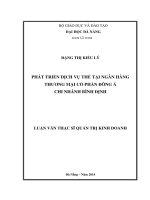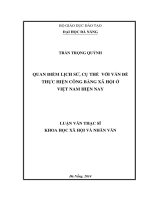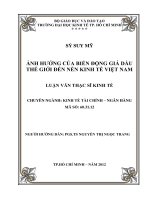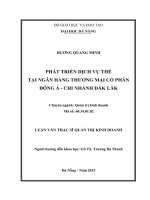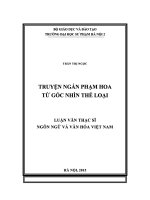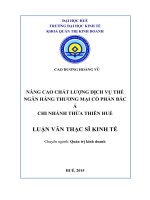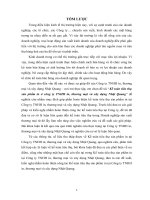(Luận văn thạc sĩ) organizational culture and organizational citizenship behavior in the service industry
Bạn đang xem bản rút gọn của tài liệu. Xem và tải ngay bản đầy đủ của tài liệu tại đây (1.23 MB, 82 trang )
UNIVERSITY OF ECONOMICS HO CHI MINH CITY
International School of Business
------------------------------
Nguyen Hoang Van
ORGANIZATIONAL CULTURE AND
ORGANIZATIONAL CITIZENSHIP
BEHAVIOR IN THE SERVICE INDUSTRY
MASTER OF BUSINESS (Honours)
Ho Chi Minh City – Year 2012
UNIVERSITY OF ECONOMICS HO CHI MINH CITY
International School of Business
------------------------------
Nguyen Hoang Van
ORGANIZATIONAL CULTURE AND
ORGANIZATIONAL CITIZENSHIP
BEHAVIOR IN THE SERVICE INDUSTRY
ID: 60340102
MASTER OF BUSINESS (Honours)
SUPERVISOR: Dr. Nguyen Huu Lam
Ho Chi Minh City – Year 2012
ACKNOWLEDGEMENTS
This thesis could not have been completed without the support, guidance and
encouragement of many people.
First of all, I would like to express my genuine appreciation to my supervisor, Dr.
Nguyen Huu Lam, for the precious time of countless advice and sharing his wisdom
of knowledge and experience in every stage of my study. I could not have
completed this research without his teaching, support and assistance.
I would also like to thank the committee members, Dr. Nguyen Dinh Tho, Dr.
Nguyen Dong Phong, Dr. Tran Ha Minh Quan, Dr. Nguyen Thi Mai Trang and Dr.
Nguyen Thi Nguyet Que. Thanks for their advice, willingness to help and insightful
comments. I am thankful to all staffs of International School of Business for their
support and help during the last two years as well as their experience sharing. There
are also a lot of other professors, classmates, colleagues and friends who supported
me in the long journey of my graduate study.
Lastly, I owe a great gratitude to my family. I could not have completed this
achievement without their continued support and encouragement.
Ho Chi Minh City, December 31st, 2012
Nguyen Hoang Van
Organizational Culture and Organizational Citizenship Behavior in the Service Industry
Page i
ABSTRACT
Research on organizational citizenship behavior (OCB) has received considerable
attention over the past several decades. OCB is defined as the discretionary
contributions of employees that beyond a job description and do not formally result
in reward. Previous research have identified a wide range of antecedents of OCB,
including
attitudinal
variables
(e.g.,
satisfaction,
perceptions
of
justice,
organizational commitment), individual characteristics (e.g., conscientiousness,
agreeableness, positive affectivity) and elements within the organization (e.g.,
leadership, organizational supportiveness, task characteristics). The purpose of
current study is finding out the correlation between organizational culture and OCB.
The research was done by quantitative approach. Data was collected from 342
respondents who are employees from service companies in Ho Chi Minh City. A
two-step approach in SEM was employed to analyze the data. Confirmatory factor
analysis (CFA) was used to validate the measurement scale of organizational
culture and organizational citizenship behavior. And structural equation model
(SEM) was used to measure the influence of organizational culture on OCB as well
as measure the impact of each dimensions of organizational culture on OCB.
The statistical result identified that organizational culture has a positive impact on
OCB. Among seven dimensions of organizational culture, three dimensions affected
positively on OCB: Competitiveness, Performance Orientation and Stability; four
remain dimensions Social Responsibility, Innovation, Supportiveness and Emphasis
on Reward did not impact on OCB.
Based on result of data analysis, managerial implications have been discussed;
limitations and further research directions have also been indicated.
Organizational Culture and Organizational Citizenship Behavior in the Service Industry
Page ii
TABLE OF CONTENTS
ACKNOWLEDGEMENTS
ABSTRACT
TABLE OF CONTENTS
LIST OF TABLES
LIST OF FIGURES
CHAPTER I: INTRODUCTION ............................................................................ 1
I.1
BACKGROUND .......................................................................................... 1
I.2
RESEARCH OBJECTIVE ......................................................................... 3
I.3
RESEARCH QUESTIONS ......................................................................... 5
I.4
SCOPE OF THE STUDY ............................................................................ 5
I.5
THESIS STRUCTURE ............................................................................... 5
CHAPTER II: LITERATURE REVIEW............................................................... 7
II.1
ORGANIZATIONAL CITIZENSHIP BEHAVIOR (OCB) ................... 7
II.1.1
Definition of Organizational citizenship behavior (OCB) ................ 7
II.1.2
The roots of OCB within organizational theory ................................ 8
II.1.3
The development of the concept of OCB .......................................... 10
II.1.4
OCB Dimensions: ................................................................................ 12
II.1.5
Antecedents and Consequences of OCB ........................................... 15
II.2
ORGANIZATIONAL CULTURE ........................................................... 16
II.2.1
Definition and the importance of organizational culture................ 16
II.2.2
Levels of organizational culture ........................................................ 18
II.2.3
Dimensions and types of organizational culture .............................. 19
Organizational Culture and Organizational Citizenship Behavior in the Service Industry
Page iii
II.3
RESEARCH HYPOTHESIS: ................................................................... 23
II.4
MODEL ...................................................................................................... 25
CHAPTER III: RESEARCH METHODOLOGY ............................................... 26
III.1 CONSTRUCT MEASUREMENT AND QUESTIONNAIRE ............... 26
III.1.1 Questionnaire ...................................................................................... 26
III.1.2 Construct measurement ..................................................................... 26
III.2 DATA COLLECTION AND SAMPLING .............................................. 29
III.3 DATA ANALYSIS ..................................................................................... 30
CHAPTER IV: DATA ANALYSIS ....................................................................... 32
IV.1 ANALYSIS RESULTS .............................................................................. 32
IV.2 DESCRIPTIVE ANALYSIS ..................................................................... 32
IV.3 CHECK THE RELIABILITY OF MEASUREMENT SCALE BY
CRONBACH’S ALPHA ...................................................................................... 33
IV.4 CONFIRMATORY FACTOR ANALYSIS (CFA)................................. 35
IV.5 STRUCTURAL EQUATION MODEL ANALYSIS .............................. 45
IV.4.1 Estimate the casual relationship between OC and OCB. …………46
IV.4.2 Measure the impact of each dimension of OC on OCB. ................. 47
CHAPTER V: DISCUSSION, IMPLICATION, LIMITATION AND
SUGGESTION FOR FUTURE RESEARCH ...................................................... 52
V.1
DISCUSSION AND IMPLICATION ...................................................... 52
V.1.1
Discussion ............................................................................................ 52
V.1.2
Implication ........................................................................................... 53
V.2 CONTRIBUTION, LIMITATION AND SUGGESTIONS FOR
FURTHER RESEARCH ..................................................................................... 55
V.2.1
Contribution of the study ................................................................... 55
V.2.2
Limitations and further research directions .................................... 56
Organizational Culture and Organizational Citizenship Behavior in the Service Industry
Page iv
REFERENCES
APPENDICES
Appendix A: Questionnaire ......................................................................................... i
Appendix B: Regression Weights and Standardized Regression Weights of Model
(Standardized Estimates) ............................................................................................ ix
Organizational Culture and Organizational Citizenship Behavior in the Service Industry
Page v
LIST OF TABLES
Table 3.1: Organizational Culture measurement scale ............................................ 27
Table 3.2: Organizational Citizenship Behavior measurement scale ....................... 28
Table 3.3: Key goodness-of-fit indices (Byrne, 2001 and Kline, 2005) ................... 31
Table 4.1: Descriptive Analysis of respondents........................................................ 33
Table 4.2: Cronbach’s alpha of measurement scale .................................................. 35
Table 4.3: Goodness-of-fit Indices of CFA with Organizational Culture construct . 38
Table 4.4: Standardized Confirmatory Factor Analysis Coefficients, Construct
Reliability and Average Variance Extracted (Organizational Culture) ......... 40
Table 4.5: Regression Weight and Standardized Regression Weight – CFA with
OCB construct............................................................................................ 42
Table 4.6: Goodness-of-fit Indices of CFA with OCB construct ............................. 43
Table 4.7:
Standardized Confirmatory Factor Analysis Coefficients, Construct
Reliability and Average Variance Extracted (Organizational Citizenship
Behavior) ................................................................................................... 44
Table 4.8: OC and OCB scale ................................................................................... 45
Table 4.9: Regression Weight and Standardized Regression Weight – SEM 1 ....... 47
Table 4.10: Regression Weight and Standardized Regression Weight – SEM 2 ..... 49
Table 4.11: Regression Weight and Standardized Regression Weight – SEM 3 ..... 50
Organizational Culture and Organizational Citizenship Behavior in the Service Industry
Page vi
LIST OF FIGURES
Figure 2.1: There levels of organizational culture. Adapted from Organizational
Culture and Leadership by Schein, E.H (3rd ed.), 2004, San Francisco, CA:
Josses-Bass, Inc. ........................................................................................... 18
Figure 2.2: The Competing Values Framework Quadrant. Adapted from Diagnosing
and changing organizational culture by Cameron, K.S., & Quinn, R.E.,
1999. Reading, MA: Addison-Wesley ......................................................... 20
Figure 2.3: Dimensions of Organizational Culture Profile (OCP). Adapted from
People and Organizational Culture: A Profile Comparison Approach to
Assessing Person-Organization Fit by O’Reilly, Charles A.III, Chatman, J.,
& Caldwell, D.F.,1991. Academy of Management Journal 34, 487-516 .... 22
Figure 2.4: A conceptual model ................................................................................ 25
Figure 4.1: CFA with Organizational Culture construct ........................................... 37
Figure 4.2: Revised CFA – CFA with organizational culture construct ................... 39
Figure 4.3: CFA with Organizational Culture construct ........................................... 41
Figure 4.4: Revised CFA – CFA with OCB construct ............................................. 43
Figure 4.5: Structural Equation Model (SEM 1)....................................................... 46
Figure 4.6: Structural Equation Model (SEM 2)....................................................... 48
Figure 4.7: Structural Equation Model (SEM 3)....................................................... 50
Organizational Culture and Organizational Citizenship Behavior in the Service Industry Page vii
Chapter I: Introduction
CHAPTER I
INTRODUCTION
This chapter presents general information about organizational citizenship behavior
and the importance of developing organizational citizenship behavior in the
organization. The research objective, research questions and scope of the study are
also discussed in this chapter.
I.1 BACKGROUND
Utilizing current resources is one of the factors for the success in any organization.
In order to achieve the highest utilization, managers should understand the different
types of individual behavior inside the organization. McShane and Von Glinow
(2008) discussed types of work-related behaviors. They are:
- Task performance
- Exhibiting Organizational Citizenship
- Counterproductive Work Behavior
- Joining and Staying in the Organization
- Maintaining Work Attendance
While other positive behaviors are related directly to the employee’s productivity
within his role, organizational citizenship behavior (OCB) focuses on extra
activities performed by the employee beyond his formal duties. OCB as definition is
a type of organizational behavior that goes beyond existing role expectations
(Organ, Podsakoff & MacKenzie, 2006). OCB includes positive and constructive
behaviors that employees do by their own volition, which supports co-workers and
benefits the company. Typically, employees who frequently engage in OCB may
not always be the top performers but they are the ones who are known to “go the
extra mile” or “go above and beyond” the minimum efforts required to do a merely
satisfactory job. The study of OCB dates back several decades. Since 1980s, with
the introduction of the term Organizational Citizenship Behavior by Organ and his
Organizational Culture and Organizational Citizenship Behavior in the Service Industry
Page 1
Chapter I: Introduction
colleagues, interest in this type of activity has increased. There are a variety of
labels have been used to describe behaviors that in general fit the definition of OCB
such as: citizenship performance, citizenship behavior, contextual performance,
prosocial organizational behavior, organizational spontaneity and extra role
behavior, etc. Most of OCB concepts suggest two dimensions distinguished by the
intended target of the behavior:
Organizational citizenship behavior aimed at individuals (OCBI): These are
behaviors that immediately benefit specific individuals and indirectly contribute to
the organization. The help can be work-related, for example assisting a workmate
with a specific task or help them with a personal problem.
Organizational citizenship behavior aimed at the organization (OCBO): These
are behaviors that benefit the organization in general; for example offering ideas to
improve the functioning of the organization, take action to protect the organization
from potential problems or demonstrate concern about the image of the company,
etc.
OCB is important for effective functioning of an organization because its ultimate
goal is to make all employees work toward achieving the organization goals rather
than accomplishing their duties. The organization will benefit from encouraging
employees to engage in OCB, because it has been shown to increase productivity,
efficiency, employee satisfaction and customer satisfaction, reduce cost, rate of
turnover and absenteeism. OCB can be extremely valuable to the organization; it
can contribute to individual performance, organization performance and competitive
advantage. OCB is crucial to the survivor of an organization (Podsakoff, Whiting,
Podsakoff & Blume, 2009).
A rapidly changing economic environment, characterized by such phenomena as
globalization and deregulation of markets, changing customer, investor’s demand
and ever-increasing product-market competition, has become the norm for most
Organizational Culture and Organizational Citizenship Behavior in the Service Industry
Page 2
Chapter I: Introduction
organizations. To compete, organizations must continually improve their
performance by reducing costs, innovating products and processes, improving
quality, productivity and speed to market. Almost organizations evaluate human as
the most important and valuable asset, especially employee who have OCB.
According to Podsakoff, MacKenzie, Paine & Bachrach (2000), employees provide
organizations with unique human resource capabilities that can create a competitive
advantage, and OCB is one type of behavior that may contribute to that advantage.
Organizations have to find ways to benefit from human resources and subsequently
have to make sure their employees contribute to their competitive advantage. OCB
can be an important factor that might distinguish the employees from one
organization and those of another one. Nowadays, many organizations have to cope
with a decrease in revenues and the competition among similar organizations is
growing harsher. Wouldn’t it be desirable to find a competitive advantage that
contributes to an increase in performance without requiring any financial
investment? The answer for this question is OCB. Obviously, in order to get the
high performance, organizational citizenship behavior is one of the important issues
the organization should pay attention to. In other words, companies need to research
factors which may impact on OCB so that they can apply them to develop OCB in
their organization.
I.2 RESEARCH OBJECTIVE
Organizational citizenship behavior (OCB) has been of increasing interest to both
scholars and managers, because it suits the changing competitive environment of
the market. There are two directions in research about OCB. The first direction
focuses to identify factors affect to OCB and the second direction measures the
impact of OCB on performance.
Ancetedents
OCB
Performance
Organizational Culture and Organizational Citizenship Behavior in the Service Industry
Page 3
Chapter I: Introduction
In the first direction, there are a lot of researches define factors influence on OCB.
Podsakoff et al. (2000) has focused on four major categories of antecedents:
employee characteristics, task characteristics, organizational characteristics and
leadership behaviors. Employee characteristics include Employee Attitudes
(employee satisfaction, organization commitment, perception of fairness and
perceptions of leader supportiveness), Dispositional Variables (conscientiousness,
agreeableness, positive affectivity and negative affectivity); Role Perception and
Demographic Variables. The second category, task characteristics include task
feedback, task routinization and intrinsically satisfying task. The category of
organization characteristics mentioned organizational formalization, organizational
support and inflexibility. The last category is leadership behaviors (“core”
transformational behaviors, articulating a vision, providing an appropriate model,
fostering the acceptance of group goals, high performance expectations, and
intellectual stimulation, contingent reward behavior, supportive leader behavior and
Leader-Member Exchange). These characteristics especially task characteristic,
organizational characteristics and leadership behavior are somehow affected by
organizational culture. Therefore, this study investigates the relationship between
organizational culture and organizational citizenship behavior as well as measure
the impact of organizational culture on organizational citizenship behavior. Because
organizational culture will be different among kinds of organizations, this research
focuses to find the relationship between organizational culture and organizational
citizenship behavior in the service industry.
Although organizational culture and organizational citizenship behavior have
developed since 1980, they are still popular and attract a lot of attention by both
scholars and managers up to now. A numbers of researches about OCB have been
done in many countries but the concept organizational citizenship behavior is
unfamiliar one in Vietnam. There is a little researches about this behavior and has
no research about the relationship between organizational culture and organizational
citizenship behavior. In over the world, there are some studies found out this
Organizational Culture and Organizational Citizenship Behavior in the Service Industry
Page 4
Chapter I: Introduction
relationship. Previous studies indicated that organizational culture has an impact on
organizational
citizenship
behavior.
And
now
the
relationship
between
organizational culture and organizational citizenship behavior is tested in Vietnam
context to check if it is significant or not. In addition, although previous studies
measured the impact of organizational culture on OCB; however, each research
considered organizational culture as different perspective and they used
organizational culture measurement scales differently. This research modifies to the
present researches by using Organizational Culture Profile (OCP) of O’Reilly et al.
(1991), modified by Sarros et al. (2005) as a measurement scale of organizational
culture.
I.3 RESEARCH QUESTIONS
The purpose of the present research is to answer two following questions:
1. Is there a relationship between organizational culture and organizational
citizenship behavior?
2. How does each dimension of organizational culture effect to organizational
citizenship behavior?
I.4 SCOPE OF THE STUDY
As mentioned, because organizational culture is not the same among kinds of
organization; for example, culture of service companies is quite different with
culture of manufacturer companies. Therefore, this research just only focuses to
measure the impact of organizational culture on organizational citizenship behavior
in the service industry.
In addition, due to the limited resources and time, the empirical data for the research
was collected from service companies in Ho Chi Minh City, which is considered as
the most dynamic city in Vietnam.
I.5 THESIS STRUCTURE
This research is organized in five chapters with details as below:
Organizational Culture and Organizational Citizenship Behavior in the Service Industry
Page 5
Chapter I: Introduction
Chapter 1: Introduction. It provides information about the main construct, research
objective, research questions, scope of the study and research structure.
Chapter 2: Literature review. This chapter reviews related literature to the research
questions of the study. The literature mentions about organizational culture and
organizational citizenship behavior as well as the relationship between them.
Hypothesis and model are also described in this chapter.
Chapter 3: Research methodology. This part includes topics: construct measurement
and questionnaire, data collection and sampling and method to analyze the data.
Chapter 4: Data Analysis. This chapter translates the data collected from survey to
answer research questions.
Chapter 5: Discussion, Managerial Implication, Limitation and Suggestion for
future research. The final part of the thesis give discussion about the research
finding, the implication for management as well as describing limitations and
suggestions for future research.
Organizational Culture and Organizational Citizenship Behavior in the Service Industry
Page 6
Chapter II: Literature Review
CHAPTER II
LITERATURE REVIEW
This chapter reviews related literature to the research questions of the study. The
literature concerning organizational culture and organizational citizenship behavior
as well as the relationship between them is examined. The hypothesis to be tested in
this study and the model are provided along with the literature support to
hypothesis.
II.1
ORGANIZATIONAL CITIZENSHIP BEHAVIOR (OCB)
II.1.1 Definition of Organizational citizenship behavior (OCB)
Dennis Organ is generally considered as the father of OCB. Organ (1988) defined
OCB as “individual behavior that is discretionary, not directly or explicitly
recognized by the formal reward system, and that in the aggregate promotes the
effective functioning of the organization” (p.4). Organ’s definition includes three
critical aspects that are central to this construct. First, OCB is thought of as
discretionary behaviors, which are not part of the job description, and are performed
by the employee as a result of personal choice. In other words, OCB is always a
type of voluntary behavior that could not be enforced by superiors. Second, OCB go
above and beyond that which is an enforceable requirement of the job description.
Although some components of OCB are in-role behaviors, for example, be on time,
maintain a clean work place, give advance notice when unable to come to work, etc.
are required but everything that goes beyond this level is voluntary and therefore
not directly recognized by the formal reward system. Even though per definition,
OCB is “not directly or explicitly recognized by the formal reward system” it does
not means that OCB is limited to those gestures remaining unrewarded. OCB does
not require remaining unrewarded, but a reward for OCB could not be contractually
guaranteed. Finally, OCB contribute positively to overall organizational
Organizational Culture and Organizational Citizenship Behavior in the Service Industry
Page 7
Chapter II: Literature Review
effectiveness. Later, Organ defined OCB as a factor helping to maintain and
increase a spiritual, psychological and social concept which enhances performance
(Organ, 1997).
II.1.2 The roots of OCB within organizational theory
Before OCB is first mentioned in scientific articles, some researchers describes
types of behavior which similar to OCB such as “willingness to cooperate” of
Barnard (1938), “informal collaboration” of Roethilisberger and Dickson (1939),
and “patterns of individual behavior” of Katz and Kahn (1967)
The first concept is Barnard’s theory of the “cooperative system”. While other
researchers at that time emphasized on the formal structure and control of
organization, Barnard defined the nature of organization differently. He insisted that
willingness of persons to contribute efforts to the cooperative system is
indispensable (Barnard, as cited in Organ et al., 2006). Accordingly to Barnard,
willingness to contribute went beyond the execution of specific tasks in exchange of
contractual compensation. In order to make the organization work, every participant
is required to behave some certain way and some commitment. As a result, they
share understanding and the spontaneous contributions of every single member
contribute benefit for the whole organization. The term “willingness” indicates that
these behaviors are voluntary and no one could not enforce, it is up to the
participants to eager to contribute to the organization or not. Barnard believed that
the roots of the willingness to cooperate are the combination between general
satisfaction and compatibility of employees (Barnard, as cited in Organ et al.,
2006). The nature of term “willingness” enclosed with its determinants is similar to
the concept of OCB and its determinants. The voluntariness which Barnard called
“willingness to cooperate” was what Organ called “discretionary behavior”.
Another concept of organization theory similar to OCB is “informal cooperation”.
In a book named Management and Worker published in 1939, Roethlisberger and
Organizational Culture and Organizational Citizenship Behavior in the Service Industry
Page 8
Chapter II: Literature Review
Dickson made a distinction between formal organization and informal organization.
The formal organization was characterized by the system of rules and policies
related the worker’s task, and the informal organization was marked by the informal
differentiation and integration of the individuals. They also emphasis that the
informal system should not be considered as opposite construct of the system.
Instead of, it should be viewed as a necessary condition for collaboration that makes
the formal organization work better (Organ et al., 2006). A similarity between two
concept, OCB and “informal cooperation” is the commitment beyond formal job
requirement and it positively contributes to the organization’s performance. Another
similarity of two these concepts is the effect of job satisfaction on both types of
behavior. Therefore, “informal collaboration” of Roethlisberger and Dickson is also
considered as one possible root of OCB.
Another concept is “patterns of individual behavior” of Katz and Kahn (1967). Two
these authors identified that there were three types of patterns of individual behavior
required for the function and effectiveness of organization. The first type of
behavior is to join and stay within the system. The second type is dependable
behavior. This describes behavior employee have to do to fulfill their job
requirement. And the last type of behavior is innovative and spontaneous behavior,
describes employee’s behavior that beyond role requirement for accomplishments
of organization functions (Katz & Kahn, 1967). A similarity of this concept to OCB
is they are discretionary behaviors which are done by employee volition,
unpredictable and uncontrollable and could be forced by any person include
superior. In addition, these concepts describe behaviors that go beyond the job
requirement, being essential for the functioning of the organization and contribute
to the overall performance of organization.
Organizational Culture and Organizational Citizenship Behavior in the Service Industry
Page 9
Chapter II: Literature Review
II.1.3 The development of the concept of OCB
In 1977, Organ published a paper to support the popular opinion that satisfaction
had an effect on productivity. He distinguished between “quantitative measures of
output or productivity and other, more subtle, forms of worker contribution that
often are not reflected in measures of individual output” (Organ et al., 2006, p.15).
These contributions might manifest themselves by helping coworkers, contributing
to the organization’s rule and its culture as well as adapting to changes made by
managers. The purpose of Organ was not introducing the new concept OCB.
However, two of his students Bateman and Smith were interested in doing some
research to justify or to disprove Organ’s ideas.
In 1983, Bateman and Organ conducted a study to find out the relationship between
job satisfaction and performance. They took into account not only the quantity of
output but also those gestures of supra-role behavior which are necessary to make
an organization well functioning. Examples of such behavior are helping colleagues
with job-related problems, accepting a temporary overload of work without
complaint, avoiding interpersonal conflicts, protecting organizational resources and
communicating a positive image of the organizations to outsiders. The result of this
research indicated that not only was the correlation between earlier job satisfaction
and later citizenship behavior significantly positive, but also the correlation between
earlier citizenship behavior and later job satisfaction. Furthermore, the significance
between qualitative (citizenship) and quantitative performance was higher than
hypothesis (Bateman & Organ, 1983). Anna Smith was continuing with this
research by asking supervisors in manufacturing plants “What are the things you
would like your employees to do more of, but really can’t make them do, and for
which you can’t guarantee any definite rewards, other than your appreciation?”
(Smith, Organ & Near, as cited in Organ et al., 2006). Here are the answers to this
question that have been given most frequently.
Organizational Culture and Organizational Citizenship Behavior in the Service Industry Page 10
Chapter II: Literature Review
- Helps other employees with their work when they have been absent
- Exhibits punctuality in arriving at work on time in the morning and after lunch
and breaks
- Volunteers to do things not formally required by the job
- Takes undeserved work breaks
- Takes initiative to orient new employee to the department even though it is not
part of his/her job description.
- Exhibits attendance at work beyond the norm (for example, takes fewer days off
than most individuals or fewer than allowed)
- Helps others when their workload increases (assists others until they get over the
hurdles)
- Coasts toward the end of the day*
- Gives advance notice if unable to come to work
- Spends great deal of time in personal telephone conversation*
- Does not take unnecessary time off work
- Assists me with my duties
- Makes innovative suggestions to improve overall quality of the department
- Does not take extra-breaks
- Willingly attends functions not required by the organization but that help its
overall image
- Does not spend a great deal of time in idle conversation
Then, Smith continued to define forms of the citizenship behaviors by asking a
group of her MBA students who were as working managers to think of a specific
coworker and to rate the frequency with which the coworker engages in such
behaviors. She found that there were at least two factors of OCB. The first one is
Altruism. Altruism describes behaviors of employee to support new employees to
get acquainted with their job or to help colleagues who have work load. This
dimension was later called Helping. The remained factor was called Generalized
Compliance and later Conscientiousness. Example of this dimension are being
Organizational Culture and Organizational Citizenship Behavior in the Service Industry Page 11
Chapter II: Literature Review
punctual, not taking unnecessary breaks, avoiding absence and private
conversations during working time. Other dimensions of OCB which have been
added later are Sportsmanship, Courtesy and Civic Virtue. An example of
Sportsmanship is not to complain, Courtesy is avoid creating problem with
colleagues and Civic Virtue “describes a posture of responsible, constructive
involvement in the political or governance process of the organization” (Organ et
al., 2006, p. 18-24). Later, Organ added two other types of OCB Cheerleading and
Peacemaking. Employees do Cheerleading when they show respect and recognition
of good work for workmate. And employees express Peacemaking behavior when
they recognize the conflict between their colleagues and intervene as moderator.
Podsakoff et al. (2000) added two more dimensions of OCB Organizational Loyalty
and Self-Development. Organizational Loyalty means promoting the organization to
outsiders, protecting and defending it against external threats, and remaining
committed to it even under adverse conditions. Self-Development includes
voluntary behaviors employees engage in to improve their knowledge, skills and
abilities.
II.1.4 OCB Dimensions
There are different opinions about the dimensions of OCB. Different researchers
have considered different dimensions for OCB.
Helping
This dimension was called Altruism at the beginning, and then it was changed into
Helping because Altruism was criticized to imply selflessness as a motive behind
the behavior and limited the dimension thereby to those gestures which were driven
by selfless motivators. (Organ et al., 2006). Regardless of its denomination
(Helping or Altruism), the nature of this type of OCB is
direct at a specific individual-usually a coworker, but sometimes the
supervisor or customer. In other words, the target of the behavior, the
Organizational Culture and Organizational Citizenship Behavior in the Service Industry Page 12
Chapter II: Literature Review
immediate beneficiary, is a person. This factor includes items such as helping
a new worker learn the job or helping an overloaded worker catch up with the
workflow or solve a problem (Organ et al., 2006, p.18)
Podsakoff at al. (2000) included two dimensions Cheerleading and Peacemaking of
Organ and some of behaviors of Courtesy intended to avoid problems in this
dimension.
Courtesy
Organ (1988) considered Courtesy as one dimension of OCB while Podsakoff et al.
(2000) mentioned it should be included in Helping dimension. According to Organ
et al. (2006) whereas helping pertains to mitigating or solving problem confronted
by a colleague, Courtesy consists of actions that help prevent problems from
occurring. The basic idea is to avoid practices that make other people’s work harder
and when you have to add to their load, to give them enough notice that they’ll be
prepared to deal with it.
Item to measure Courtesy are
- Tries to avoid creating problems for others
- Considers the effects of his/her actions
- Consults with me or other people who might be affected by his/her actions or
decisions
- Informed me before taking any important actions
(Konovsky and Organ, 1996)
Sportsmanship
Showing tolerance and forgiveness in difficult and critical conditions without
complaint is referred to as Sportsmanship. Employees engage Sportsmanship not
only do not complain when they are inconvenienced by others, but also maintain a
positive attitude even when things do not go their way (Podsakoff et al., 2000)
Organizational Culture and Organizational Citizenship Behavior in the Service Industry Page 13
Chapter II: Literature Review
Items to measure Sportsmanship (Konovky & Organ, 1996)
- Complains a lot about trivial matters*
- Always find fault with what the organization is doing*
- Expresses resentment with any change introduced by management*
- Thinks only about his/her work problems, not others’*
- Tries to make the best of situation, even when there are problems
- Is able to tolerate occasional inconveniences when they arise
- Does not complain about work assignments
Compliance
Like
Helping
dimension,
Compliance
dimension
was
initially
labeled
Conscientiousness, and then it was renamed Compliance to avoid confusions with
the personality factor labeled Conscientiousness. It describes items that did not have
the immediate effect of helping a specific person but rather contributed in a more
impersonal and generalized fashion to the group, department, or organization. For
example, punctuality in arriving at work or at meetings, exemplary attendance, and
refraining from unnecessary breaks and idle conversation do not appear to help any
specific individual (although one could make the case that such behavior does, at
least indirectly, help the supervisor or manager). What these behaviors exemplify is
a particularly high order of compliance with constraints upon individuals necessary
to make a cooperative system (Organ et al., 2006). Podsakoff et al. (2000) described
an employee engage Compliance is an employee who obeys all rules and
regulations even when no one is watching.
Civic Virtue
It refers to the responsibility which employees undertake as a member of
organization. It’s also providing a favorable image of the organization for the
outsiders, such as recognition of environmental opportunities and threats even at
their personal expense.
Organizational Culture and Organizational Citizenship Behavior in the Service Industry Page 14
Chapter II: Literature Review
Items to measure Civic Virtue are
- Stays informed about developments in the company
- Attends and participates in meetings regarding the company
- Offers suggestions for ways to improve operations
(Konovsky & Organ, 1996)
Organizational Loyalty
This dimension consist behaviors which protect and defend the image and good
reputation of the organization towards the external environment.
Self development
It is voluntary behaviors employees engage in to improve their knowledge, skills
and abilities (Podsakoff et al., 2000)
In conclusion about the dimension of OCB, there are seven dimensions according
Organ and Podsakoff et al. However, just only five of them gained most of the
attention of researchers. These dimensions are Altruism (respectively Helping),
Conscientiousness (respectively Compliance), Courtesy, Sportsmanship and Civic
Virtue.
II.1.5 Antecedents and Consequences of OCB
Determining why individuals engage in OCB has occupied a substantial amount of
research attention in both organization behavior and social psychology. A number
of predictors of OCB has been identified including job attitudes (Organ, 1988),
interpersonal trust or loyalty to the leader (Podsakoff et al., 1990), transformational
leadership behavior (Eisanberger, Hutchison, & Sowa, 1986; Greenberg, 2005), task
characteristics (Podsakoff et al., 1990), organizational justice (Moorman, 1991),
cultural influence (Farh, Earley & Lin, 1997), civic citizenship and covenantal
relationship (Van Dyne et al., 1994; Graham, 1991), dispositional influences (Van
Organizational Culture and Organizational Citizenship Behavior in the Service Industry Page 15
Chapter II: Literature Review
Dyne, Graham & Dienesch, 1994; Moorman & Blakely, 1995) and contextual
influences (Niemeyer, Boles, McKee & McMurrian, 1997).
Beside focus on the antecedents of organizational citizenship behavior, there are a
lot of researches have attention to the consequence of OCB. These studies
concentrated on two key issues: the first issue is the effects of OCB on managerial
evaluation of performance and judgments and the second issue is the effects of OCB
on organizational performance and success (Podsakoff et al., 2000).
II.2
ORGANIZATIONAL CULTURE
II.2.1 Definition and the importance of organizational culture
Most organization scholars and observers recognize that organizational culture has a
powerful effect on the performance and long-term effectiveness of organizations.
Indeed, culture can affect business performance in a number of ways, both positive
and negative. For example, cultures that are not aligned with corporate strategy can
lead to decreased loyalty, a lack of motivation and high employee turnover. In
contrast, healthy cultures deliver pride and sense of purpose to employees, leading
to increased productivity and a greater understanding of corporate goals.
Organizational culture has been an area in which conceptual work and scholarship
have provided guidance for managers as they have research for ways to improve the
effectiveness of their organizations.
Organizational culture first appeared in the early 1960s as a synonym for
organizational climate (Munro, Schumaker & Carr, 1997). The term organizational
culture became popular in the 1980s when Peters and Waterman introduced the
book In Search of Excellence argued that the success of company could be
attributed to an organizational culture that was decisive, customer-oriented,
empowering, and people-oriented. Since then, organizational culture is a subject
which attracts a number of research studies, books and articles. Organizational
culture is considered a young but fast-growing area in management. Although
Organizational Culture and Organizational Citizenship Behavior in the Service Industry Page 16
